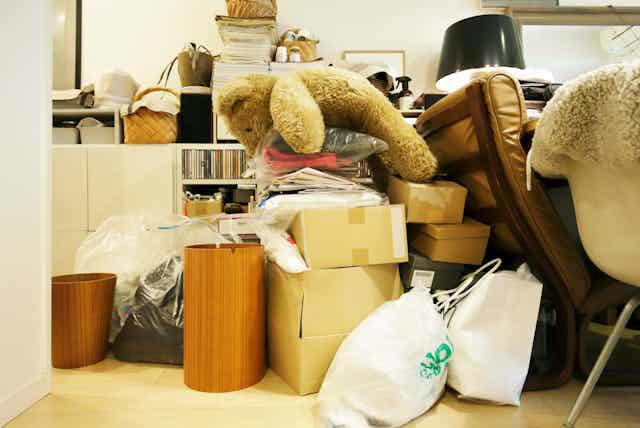Maintaining a tidy home is a never-ending challenge. And tidiness goes beyond aesthetics – it contributes to a person’s mental wellbeing.
So what are the best strategies for creating and maintaining order?
A growing body of research into tidiness and decluttering, including our own, might offer helpful insights.
As part of our ongoing research project, we analysed popular cleaning and decluttering videos on YouTube as well thousands of the comments below them. We also conducted 18 in-depth interviews. The goal is to better understand how people create order in their homes – and how they keep it that way.
As our research shows, sustaining tidiness is about being both systematic and adaptable.
Life can be the enemy of tidiness
From an early age, people are primed to shop.
But this culture of shopping clashes with the desire for tidy and clutter-free homes.
Family members with different tidiness standards and life stages can also disrupt efforts to create order.
Read more: Swedish death cleaning: how to declutter your home and life
As one young couple said:
We’ve always wanted that really amazing organised home but we could just never really get it that way and we would feel really discouraged when we tried and then just a few days later it would just go right back to messy.
Some interviewees described feeling like prisoners of their possessions.
Another young couple with two kids explained:
As more children arrived and our income increased, more stuff made its way into our home. We have never been hoarders, but at some point I looked around and realised that we were spending our time and resources on acquiring stuff, cleaning and maintaining stuff, storing stuff, moving stuff out of the way to get to other stuff.
And the very organisation systems used to maintain tidy and clutter-free homes can contribute to disorganisation.
One professional woman we spoke with described establishing a system where every piece of clothing had a designated spot in their wardrobe based on colour, type and season. Ultimately, this became too difficult to maintain, undermining the whole approach.
So what can be done to maintain a tidy home?

4 strategies for keeping your home tidy
Our research so far has helped us identify four key strategies to achieve long-term tidiness.
1: Simplify
To achieve lasting tidiness, you need to simplify the way you organise your home.
This can be done by eliminating spaces or areas in your home that encourage further organisation and classification of possessions – like extra dressers or storage units.
Read more: Clean your way to happiness: unpacking the decluttering craze
One retired couple we spoke with did just that.
We had this dresser […] that was basically always inviting more and more stuff to be put in it. So, it was always pretty hard to have the space we always wanted. Well then we got rid of the dresser […] and once we did that we really saw the space open up and it became really nice and clear.
Fewer dedicated spaces mean fewer opportunities for clutter to accumulate, ultimately making it easier to maintain a tidy living environment.
2: Create groups
Another effective strategy for long-term tidiness is to simplify how you categorise and group things in your home.
Replacing several small decor items with one larger one creates fewer distinct categories of things around the house, for example.
Read more: So you've KonMari'ed your life: here's how to throw your stuff out
One mother of two kids we spoke with switched out several small teddy bears in her lounge for one big one.
A married couple we interviewed grouped smaller knickknacks onto a tray, making it easier to keep track of things and to maintain order. Having all of their knickknacks in one place also made it easier to clean.
3: Manage numbers
To sustain long-term tidiness, it’s also essential to control the total number of possessions in your home.
This can be achieved through various methods, such as encouraging sharing among family members and friends or following the “one in, one out” rule – for every new item you bring into the house, you get rid of an old item.
Instead of buying rarely used items, like a camping tent, you could rent it when needed.
Another married couple we spoke with described a cluttered kitchen with multiple pots for different cooking jobs. Looking to reduce the clutter, they switched to using a multipurpose cast iron skillet – one item that can do many jobs.
A family with two kids spoke about sharing hair products to reduce the clutter in the bathroom.
We used to buy a bunch of different things but now we use the same thing for our hair so the product [my husband] uses, I use. We use the same shampoo. We actually used to buy different shampoo. So basically, we just simplified our product […] this brought the products down to half and now we have so much more peace of mind and the bathroom is so much easier to maintain.
4: Adapt and evolve
Maintaining a tidy home requires flexibility and a willingness to re-evaluate and adjust your routines in response to the ever-changing circumstances of your life.
A retired couple we interviewed spoke about the process of moving to a smaller place. This required getting rid of a lot of things and changing the way they lived to maximise the use of what remained.
In the end, tidiness and decluttering are ongoing processes that require dedication and flexibility.
By embracing these strategies for long-term tidiness, a person can create and maintain organised spaces that enhance their lives, fostering not only physical order but also mental clarity and peace.

